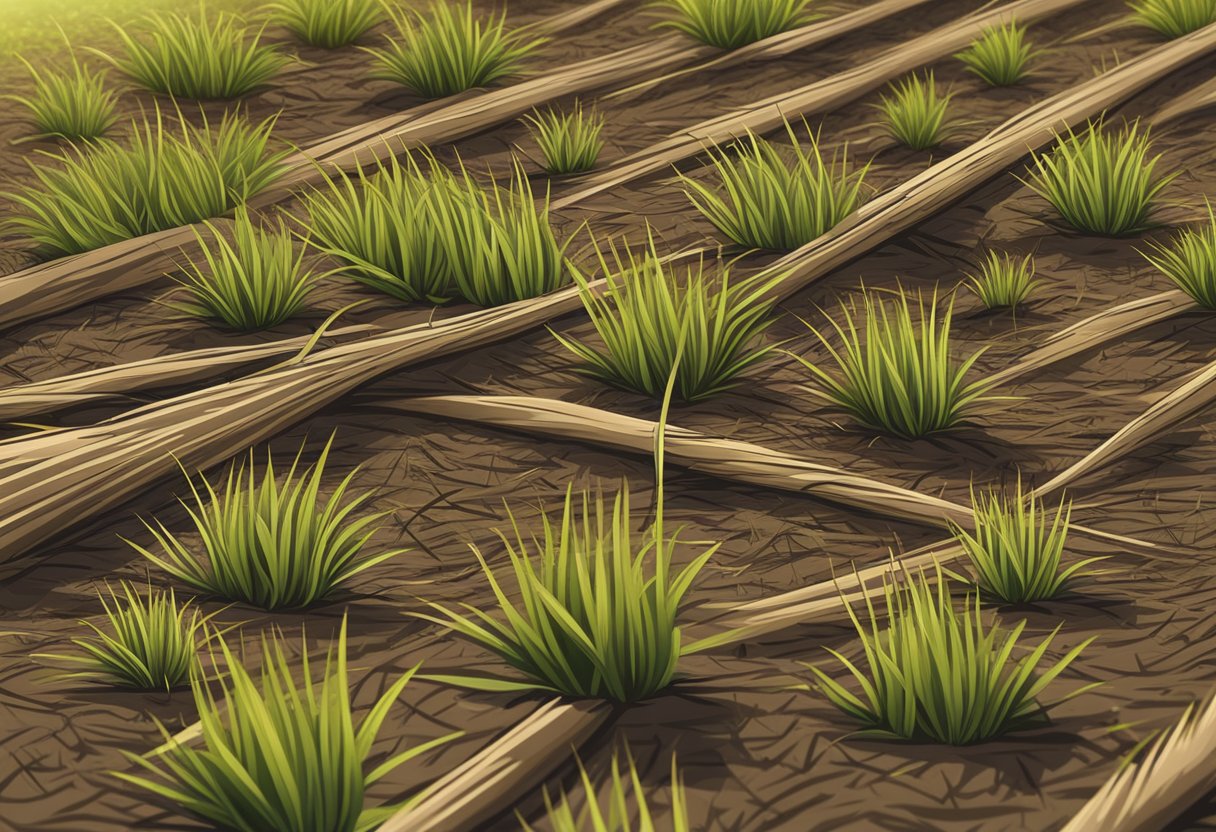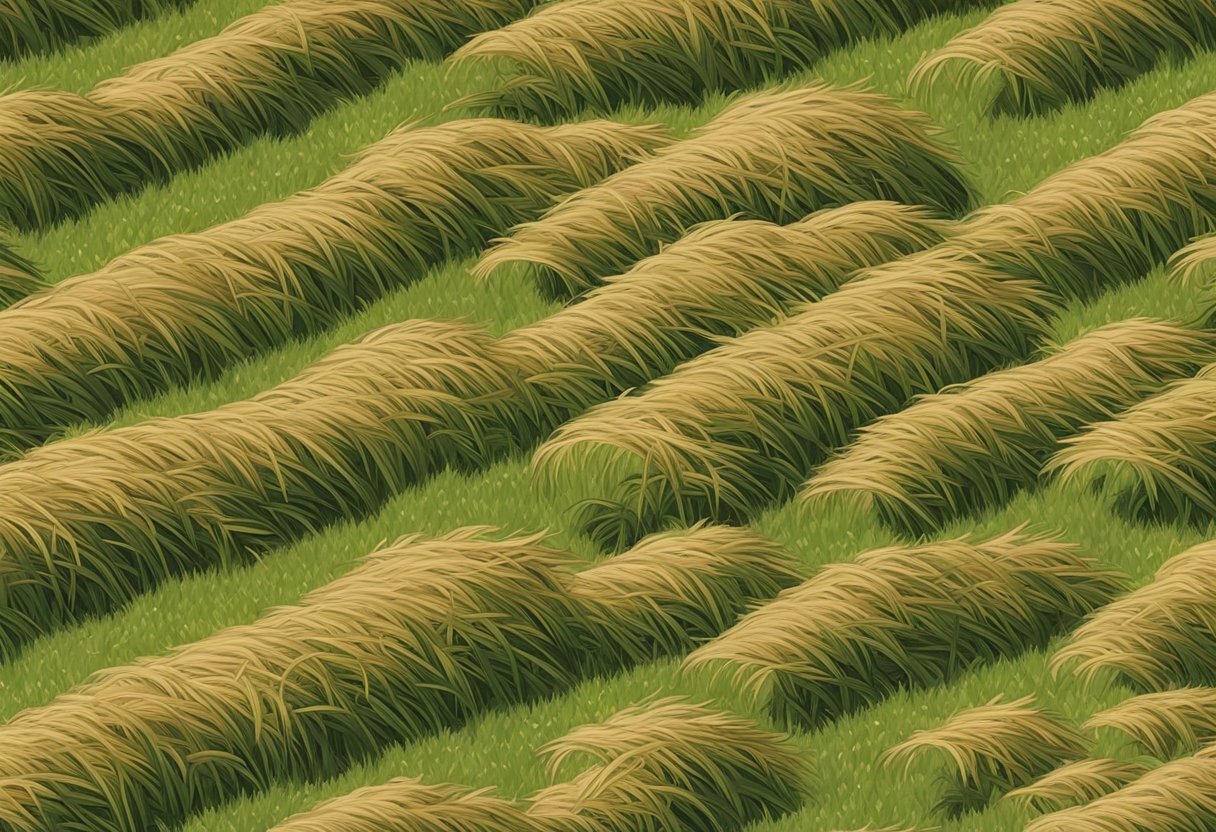Straw mulch is a versatile material commonly used in gardens and agricultural settings for its advantageous characteristics. Our experience has shown us that it’s an effective barrier against soil erosion and an excellent insulator for plant roots. When spread on the surface of the soil, it can prevent the growth of weeds, and because it’s organic, it gradually decomposes, contributing to soil health by adding organic matter and improving soil structure.

One benefit we’ve observed is its ability to retain soil moisture. By providing a protective layer, straw mulch reduces water evaporation from the soil, helping to maintain a consistent moisture level. This characteristic is particularly beneficial during dry spells, making it a staple in our water conservation efforts. Additionally, straw can be a shelter for beneficial insects and provide a clean surface for fruits and vegetables to rest on, keeping them clean and reducing disease transmission.
Our use of straw mulch also supports the notion that it is a cost-effective option. It’s typically more affordable than other mulches and because it’s a byproduct of grain production, it’s readily available. Its application doesn’t require special tools and it’s easy to handle, which lowers the energy and time we invest in mulching activities. Careful consideration must be taken to use straw free of weed seeds to avoid introducing potential problems into the garden.
Fundamentals of Straw Mulch

In our gardens, straw mulch is an organic solution that is both effective and economical. This natural product offers a range of benefits that can improve soil quality and contribute to healthy plant growth.
Definition and Types
Straw mulch refers to the layer of straw that we apply to the soil surface. It’s derived from the dry stalks of cereal plants like wheat, oats, or barley, after the grain and chaff have been removed. Several types of straw mulch are available, each with slightly different properties depending on the grain plant they come from:
- Wheat Straw Mulch: Often used in gardens; provides decent insulation and water retention.
- Oat Straw Mulch: A good choice for a quick decompose, releasing nutrients back into the soil.
- Barley Straw Mulch: Can be more challenging to find but is a weed-free straw option when properly processed.
Key Benefits and Uses
We utilize straw mulch primarily for its multiple benefits that boost garden health and productivity. Here’s a concise overview of the advantages we find when using straw as mulch:
- Moisture Retention: A layer of straw helps the soil retain water, reducing the need for frequent watering.
- Weed Suppression: It effectively suppresses weeds, minimizing garden maintenance efforts.
- Soil Temperature Regulation: Insulation properties maintain a steady soil temperature, protecting plants from extreme heat or cold.
- Soil Quality Improvement: As straw decomposes, it adds organic matter to the soil, improving soil structure and nutrient content.
- Erosion Prevention: The cover of straw reduces soil erosion caused by wind and water.
When we apply straw mulch to our gardens, we usually spread a layer about 2-4 inches thick. This layer should be sufficient to achieve the benefits mentioned while allowing for natural processes like decomposition to take place. It’s important to ensure that the straw is weed-free to prevent introducing new weeds into the garden.
Application and Management

In managing a garden or farm, the strategic application of straw mulch is crucial. It promotes soil health and brings multiple benefits throughout the growing seasons.
How to Apply Straw Mulch
To apply straw mulch, we begin by spreading it evenly around plants, ensuring it’s loose enough to allow water to penetrate. We recommend mulching in spring to suppress weeds and retain soil moisture. Adding mulch in summer can protect plants from heat and in fall, it can insulate them against cold. For vegetable gardens, a layer about 2-4 inches thick is optimal. We must be careful to keep the mulch away from plant stems to prevent rot.
When working with strawberry beds or areas prone to soil-borne diseases, mulch acts as a barrier, reducing disease spread. It’s also important to apply straw mulch to regulate soil temperature, which helps maintain a consistent growing environment.
- How Much: A layer of 2-4 inches
- When: Spring for weed suppression, Summer for heat protection, Fall for insulation
- Where: Around plants in vegetable gardens and strawberry beds, avoiding direct contact with stems
Maintaining Soil Health
For maintaining soil health, we monitor the mulch to ensure it doesn’t decompose too quickly and deplete nitrogen from the soil. If necessary, we can add an organic fertilizer to balance the nitrogen levels. Mulch naturally decomposes and adds to the composting process, improving soil structure over time. This practice minimizes the need for herbicides, as mulch effectively prevents weed growth.
We keep the mulch layer consistent throughout the season to keep the soil moist and reduce the frequency of watering. Additionally, mulch plays a role in disease control by keeping plant foliage dry and minimizing contact with soil-borne diseases. We always use straw that is free of seeds to avoid introducing weeds into the garden.
- Nitrogen Management: Add organic fertilizer if mulch decomposes rapidly
- Water Retention: Maintain a consistent mulch layer
- Disease Control: Use seed-free straw to minimize soil diseases